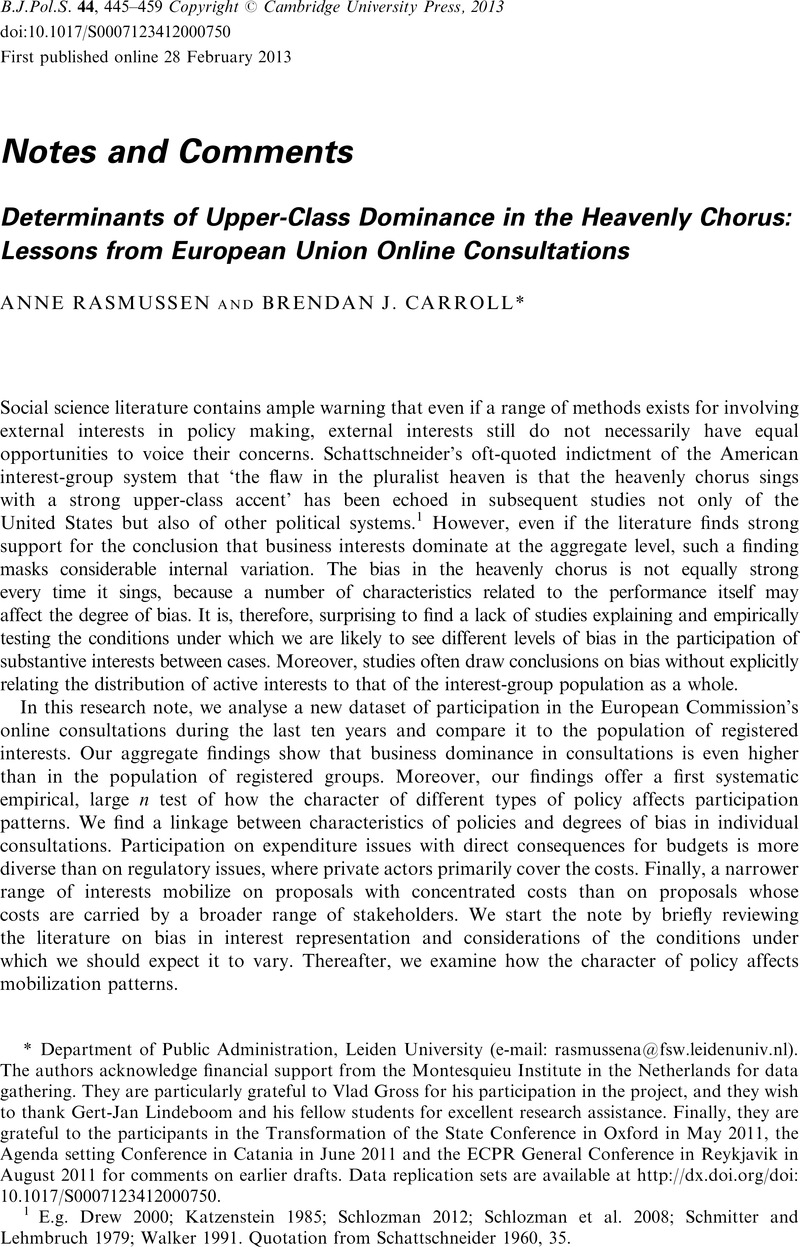Crossref Citations
This article has been cited by the following publications. This list is generated based on data provided by
Crossref.
Bunea, Adriana
2014.
Explaining Interest Groups' Articulation of Policy Preferences in the European Commission's Open Consultations: An Analysis of the Environmental Policy Area.
JCMS: Journal of Common Market Studies,
Vol. 52,
Issue. 6,
p.
1224.
Baroni, Laura
Carroll, Brendan J
William Chalmers, Adam
Marquez, Luz Maria Muñoz
and
Rasmussen, Anne
2014.
Defining and classifying interest groups.
Interest Groups & Advocacy,
Vol. 3,
Issue. 2,
p.
141.
Berkhout, Joost
2014.
Interest Organization Demography Research in Europe.
SSRN Electronic Journal,
Van Ballaert, Bart
2015.
The Politics of Policy Formulation within the European Commission.
Journal of European Integration,
Vol. 37,
Issue. 4,
p.
509.
Berkhout, Joost
2015.
The Organization Ecology of Interest Communities.
p.
37.
Bunea, Adriana
2015.
Sharing ties and preferences: Stakeholders’ position alignments in the European Commission’s open consultations.
European Union Politics,
Vol. 16,
Issue. 2,
p.
281.
Chalmers, Adam William
2015.
Financial industry mobilisation and securities markets regulation inEurope.
European Journal of Political Research,
Vol. 54,
Issue. 3,
p.
482.
Heidbreder, Eva G.
2015.
Governance in the European Union: A Policy Analysis of the Attempts to Raise Legitimacy through Civil Society Participation.
Journal of Comparative Policy Analysis: Research and Practice,
Vol. 17,
Issue. 4,
p.
359.
Braun, Caelesta
2015.
The Organization Ecology of Interest Communities.
p.
137.
Rasmussen, Anne
2015.
Participation in Written Government Consultations in Denmark and the UK: System and Actor-level Effects.
Government and Opposition,
Vol. 50,
Issue. 2,
p.
271.
Berkhout, Joost
Carroll, Brendan J.
Braun, Caelesta
Chalmers, Adam W.
Destrooper, Tine
Lowery, David
Otjes, Simon
and
Rasmussen, Anne
2015.
Interest organizations across economic sectors: explaining interest group density in the European Union.
Journal of European Public Policy,
Vol. 22,
Issue. 4,
p.
462.
Bunea, Adriana
and
Ibenskas, Raimondas
2015.
Quantitative text analysis and the study of EU lobbying and interest groups.
European Union Politics,
Vol. 16,
Issue. 3,
p.
429.
Dür, Andreas
Bernhagen, Patrick
and
Marshall, David
2015.
Interest Group Success in the European Union.
Comparative Political Studies,
Vol. 48,
Issue. 8,
p.
951.
Bunea, Adriana
and
Thomson, Robert
2015.
Consultations with Interest Groups and the Empowerment of Executives: Evidence from theEuropeanUnion.
Governance,
Vol. 28,
Issue. 4,
p.
517.
Rasmussen, Anne
and
Gross, Vlad
2015.
Biased access? Exploring selection to advisory committees.
European Political Science Review,
Vol. 7,
Issue. 3,
p.
343.
Pagliari, Stefano
and
Young, Kevin
2016.
The interest ecology of financial regulation: interest group plurality in the design of financial regulatory policies.
Socio-Economic Review,
Vol. 14,
Issue. 2,
p.
309.
van der Graaf, Amber
Otjes, Simon
and
Rasmussen, Anne
2016.
Weapon of the weak? The social media landscape of interest groups.
European Journal of Communication,
Vol. 31,
Issue. 2,
p.
120.
Orsini, Amandine
2016.
Do Non‐State Perspectives Matter for Treaty Ratification and Implementation? The case of the European Consultation on the Nagoya protocol.
Environmental Policy and Governance,
Vol. 26,
Issue. 5,
p.
377.
Carroll, Brendan J.
and
Rasmussen, Anne
2017.
Cultural capital and the density of organised interests lobbying the European Parliament.
West European Politics,
Vol. 40,
Issue. 5,
p.
1132.
bunea, adriana
ibenskas, raimondas
and
s binderkrantz, anne
2017.
estimating interest groups’ policy positions through content analysis: a discussion of automated and human-coding text analysis techniques applied to studies of EU lobbying.
European Political Science,
Vol. 16,
Issue. 3,
p.
337.
